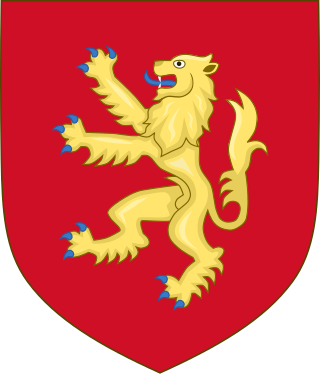Loading AI tools
Richard FitzAlan, 1st Earl of Arundel[a] (3 February 1267 – 9 March 1302) was an English nobleman and soldier.
Richard FitzAlan | |
|---|---|
| Born | 3 February 1267 |
| Died | 9 March 1302 (aged 35) |
| Buried | Haughmond Abbey, Shropshire |
| Noble family | FitzAlan |
| Spouse(s) | Alice of Saluzzo |
| Issue |
|
| Father | John FitzAlan III |
| Mother | Isabella Mortimer |

He was the son of John Fitzalan III and Isabella Mortimer, daughter of Roger Mortimer, 1st Baron Wigmore and Maud de Braose. His paternal grandparents were John Fitzalan II[4] and Maud le Botiller.
Richard was feudal Lord of Clun and Oswestry in the Welsh Marches. In 1289 he was created Earl of Arundel.[5]
He was knighted by King Edward I of England in 1289.
He fought in the Welsh wars, 1288 to 1294, when the Welsh castle of Castell y Bere (near modern-day Towyn) was besieged by Madog ap Llywelyn. He commanded the force sent to relieve the siege and he also took part in many other campaigns in Wales; also in Gascony 1295-97; and furthermore in the Scottish wars, 1298-1300.
He married sometime before 1285, Alice of Saluzzo (also known as Alesia di Saluzzo), daughter of Thomas I of Saluzzo in Italy.[6] Their issue:
- Edmund Fitzalan, 2nd Earl of Arundel.
- John, a priest.
- Alice Fitzalan, married Stephen de Segrave, 3rd Lord Segrave.
- Margaret Fitzalan, married William le Botiller (or Butler).
- Eleanor FitzAlan, married Henry de Percy, 1st Baron Percy.[b]
Richard and his mother are buried together in the sanctuary of Haughmond Abbey, long closely associated with the FitzAlan family.
- The Earls of Arundel have been numbered differently depending on whether the claims of the first seven to have been Earls by tenancy are accepted. Richard FitzAlan was the first member of the FitzAlan family to be definitely styled Earl of Arundel. He is therefore counted variously as the 1st, 6th or 8th Earl.[1]
- Standard accounts of the Percy family[citation needed] identify Eleanor as the daughter of the "Earl of Arundel". Arrangements for Eleanor's marriage to Lord Percy are found in the recognizance made in 1300 by Eleanor's father, Richard, Earl of Arundel, for a debt of 2,000 marks which he owed Sir Henry Percy.[citation needed] Eleanor was styled as a "kinswoman" of Edward II; once in 1318 and again in 1322 presumably by her descent from Amadeus IV, Count of Savoy who was the brother of Edward II's great-grandmother, Beatrice of Savoy.[citation needed] Eleanor's brothers, Edmund and John were also styled as "kinsmen" of the king.[citation needed] Eleanor's identity is further indicated by the presence of the old and new arms of FitzAlan (or Arundel) at her tomb.[citation needed]
Wikiwand in your browser!
Seamless Wikipedia browsing. On steroids.
Every time you click a link to Wikipedia, Wiktionary or Wikiquote in your browser's search results, it will show the modern Wikiwand interface.
Wikiwand extension is a five stars, simple, with minimum permission required to keep your browsing private, safe and transparent.